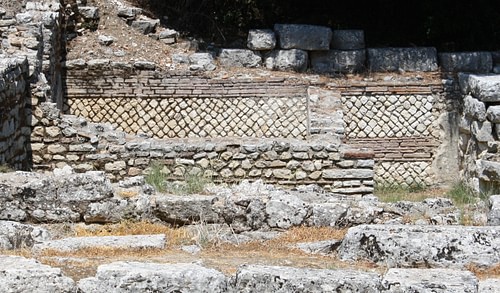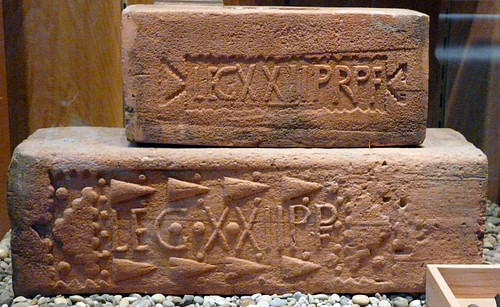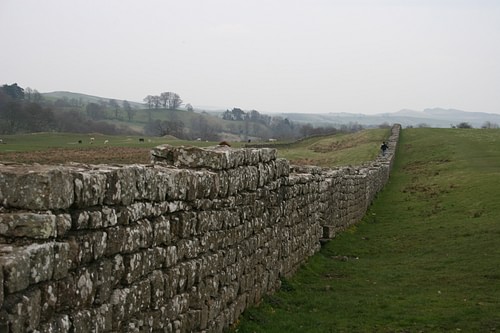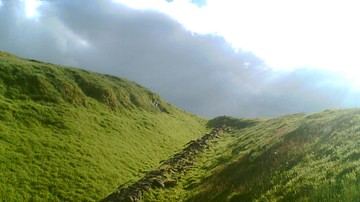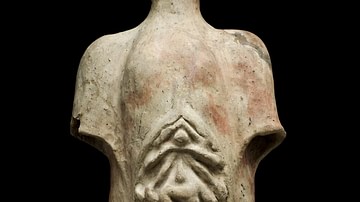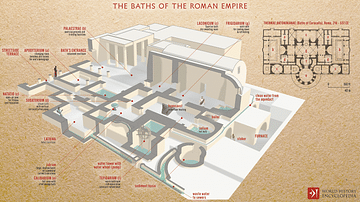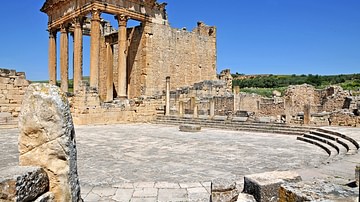The many Roman walls still visible today throughout Europe and the Mediterranean, be they defensive walls such as the Servian Wall or house and monument walls, tell us a great deal about the evolution of Roman construction techniques. Roman walls went from dry-stone and sun-dried bricks walls at the beginning of Roman civilization to walls built with a concrete core and brick facing by the beginning of the Empire. These walls also provide many clues to the history of ancient Rome and the different stages of the Roman economy and society.
EARLY ROMAN WALLS
Stone Walls
The earliest Roman walls were dry-stone walls constructed by placing stones of various sizes one upon the other without the use of any kind of mortar to bind the stones together. These walls are sometimes called Cyclopean in reference to the Greek mythology giants called Cyclopes who were considered the only ones capable of lifting stones of such enormous weight. Developments in stone cutting techniques led to construction using stones of the more similar size and form and by the 6th century BCE, the Romans had developed a wall construction method which increased the wall's strength called opus quadratum described by Latin author Vitruvius in De Architectura. Blocks of stone of the same height were set in parallel courses without mortar alternating, on the face of the wall, the longer and the shorter side of the stone block. Romans used blocks of limestome or tuff which was abundant in Rome and its surroundings, for example in quarries such as Grotta Oscura noting that tuff is a type of rock made of volcanic ash which is relatively soft and therefore easy to cut.
Sun-dried Brick Walls
Before the invention of concrete, house walls were built with stones or sun-dried mud-brick. Sun-dried mud brick or adobe has been used throughout the world for thousands of years. It is durable in dry climates and is known to have excellent thermal insulation properties. Adobe is made by mixing earth (sand, silt and clay) with water and an organic material such as straw or dung and cut into small units so that it can dry quickly without cracking. In order to ensure that walls did not crack, socles made of stone or rubble about 35 cm (14 inches) wide for single-store houses and wider for two-story houses were laid as foundations on the ground. Sun-dried mud bricks were then placed and bonded together with mud.
WALLS DURING THE REPUBLIC & EMPIRE
Concrete Revolution
By the late 3rd century BCE, the Romans revolutionized construction with the invention of concrete. Concrete was developed by experimenting with a type of mortared rubble construction called opus caementicium. It was made by adding a volcanic dust called pozzolana to mortar made of a mixture of brick or rock pieces, lime or gypsum, and water. Pozzolana which contained both silica and alumina, created a chemical reaction which dramatically strengthened the cohesiveness of the mortar. Modern concrete is about ten times stronger than Roman concrete but the pozzolana contained in opus caementicium made Roman concrete more durable against the elements. For example, recent research by U.S. and Italian scientists has shown that Roman harbors in the Mediterranean made of Roman concrete have remained intact after 2,000 years of constant pounding by the sea while the concrete of modern harbors begins to erode after only 50 years of exposure to seawater.
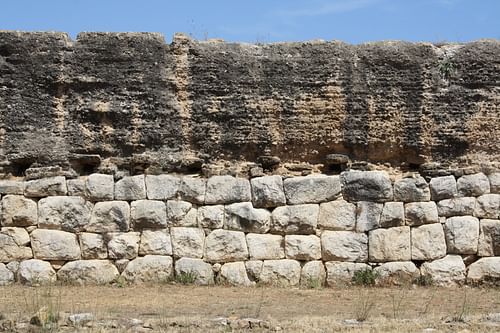
With the opus caementicium discovery, the Romans started building walls made of concrete at a much faster pace than with cut-stone constructions. Walls had an inner core which consisted of caementa (fist-sized stones) laid in abundant mortar and a facing with stone or brick, which also made walls more pleasant to look at. The facing and the core of the wall were laid and rose together as a single unit, with two masons working on opposites sides. There were many types of facings. Opus incertum, introduced around the late 3rd century BCE, was a facing which consisted of small blocks of stone placed in a random pattern. Opus reticulatum was introduced by the late 2nd century BCE and was a more regularized facing eventually consisting of square or pyramid shaped blocks of tuff set in a diagonal grid pattern. Many scholars believe that opus reticulatum was a more efficient way of constructing walls and required labor that was less skilled as tasks could easily be divided. The appearance of the opus reticulatum technique also coincides with the increase in the supply of slave labor.
During the 1st century CE, the use of the opus testaceum wall construction technique superseded opus reticulatum. Opus testaceum was a brick faced concrete rather than tuff or other stones. In the middle of the first century CE, most walls were predominantly faced with small bricks of a triangular shape. One reason for the development of brick facing was the development of the brick industry and the great fire of Rome in 64 CE under Nero which led to the building of fireproof structures. Opus mixtum is another type of opus reticulatum and was a technique which became common in the 1st and 2nd centuries CE. In the opus mixtum technique, panels of reticulatum were separated by bands of brick facing. It is believed that this technique saved on manpower and on bricks which were relatively expensive at the time. The resulting strip design can be seen in many buildings of the Late Empire and on the walls of Constantinople. The strip design was also commonly used in the later Byzantine Empire and even influenced the design of Medieval cathedrals such as the Orvieto Cathedral in Italy.
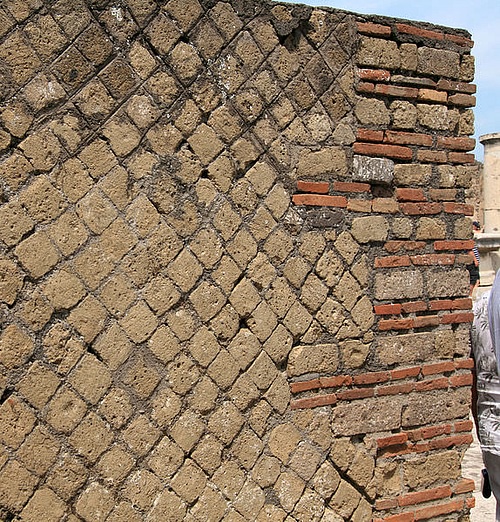
The Introduction of Fired Clay Bricks
Sun-dried mud-bricks were much weaker than fired clay bricks and could only be used for smaller constructions. As a result, stones or stone reinforcements were required for larger constructions that had no concrete in them. It is only starting from the reign of Augustus (27 BCE – 14 CE), that techniques invented by the Greeks were widely adopted to make fired clay bricks. Fire clay bricks were made from clay: clay had to be extracted from deposits, ground, mixed with water and shaped in the form of bricks. These bricks were dried and then fired in a chamber at temperatures of around 1,000 C. The clay bricks, initially green, took a red-brown color as the iron minerals naturally contained in the clay became oxidized.
The Romans developed brick-making techniques and bricks became the primary building material in the 1st century CE for the walls of houses, Roman baths, and monuments. Bricks were mostly used as a facing for concrete walls in Italy whereas in the provinces they could be used as the wall's main structural material with bands of bricks extending the full thickness of the wall. Contrary to popular belief, marble was not common in Rome. It was actually not found anywhere close to Rome and therefore was rarely used until the reign of Augustus, the founder of the Roman Empire, who famously said: "I found Rome a city of bricks and left it a city of marble". Even during the time of Augustus though, marble was only used as a facing for the walls of a few monuments such as the Temple of Venus and the Basilica Julia.
Roman bricks were longer and of a lesser height than modern bricks and made in a variety of shapes and sizes (square, rectangular, triangular, round) with the longest bricks measuring over 90 cm (3 ft) in length. The most common brick size was 1.5 Roman feet by 1 foot (1 Roman foot = 0.97 modern foot or c. 30 cm). Roman legions, who stamped bricks with their mark, also spread Rome's brickmaking know-how throughout the empire. By the early 2nd century CE, brick stamps included the name of the consuls for the year of production, thereby making it easier for archaeologists to date a specific construction.
DEFENSIVE WALLS
Servian Wall
The Romans built massive walls to defend their cities and sometimes their military camps. The method with which these walls were built changed as construction methods evolved. Initially walls were built using tightly-fitting massive irregular stone blocks similar to the walls built by the Myceneans. One of the first important defensive walls was the Servian wall (11 km or 7 mi long) named after the Roman King Servius Tullius and built around the 6th century BCE. The wall was 3.6 m (12 ft) thick at its base and up to 10 m (32.8 ft) high. It was improved following the sack of Rome by the Gauls in the 4th century BCE and proved very effective against Hannibal's army during the Second Punic War. It was built using large blocks of tuff, easily available near Rome, placed one upon the other using the opus quadratum technique. Some sections of the wall had a deep ditch to render it taller and other sections had ramps of earth along the inside of the wall to make it thicker and serve as a base for Roman soldiers.
Aurelian Walls
By the beginning of the Empire, Rome had grown outside of the Servian wall's perimeter and the wall was gradually removed during the first three centuries of the empire as Rome's territory and military strength grew. It is only during the Germanic invasions of the 3rd century CE that Emperor Aurelian built the 19 km (12 mi) long Aurelian Walls around Rome which encompassed a larger area than the previous Servian walls. They had a tower every 30 m (97 ft) or so and by the 6th century CE they possessed 383 towers, 18 main gates and were outfitted with an array of sophisticated defensive weapons including catapults.
Frontier Walls
Rome had only a few walls defending its borders. Hadrian's wall was built from 122 to 128 CE on the Pictish frontier to protect the borders of the Roman province of Britannia. It was constructed using only local materials, not concrete which required large quantities of water and not bricks which could not be locally produced in massive quantities. The wall had a core of earth or clay with stones and was faced with large stones in a soft mortar. It was 117.5 km (73 miles) long, it was from 3 m (9.8 ft) to 6 m (20 ft) thick and up to 6 m high. The wall had a fort every five Roman miles (7.5 km or 4.7 miles) comprising garrisons of infantry and cavalry.
The Antonine Wall was built from 142 to 154 CE further north of the Hadrian Wall mainly to protect the border from the Caledonians. It was approximately 63 km (39 miles) long, 5 m (16 ft) wide and 3 m (10 ft) high. The wall had stone foundations but it was built out of turf and not out of stone which is the reason why it is barely visible today. It was abandoned only eight years after completion due to its limited effectiveness.
CONCLUSION
As construction techniques evolved, so did the methods to construct walls. Wall construction in ancient Rome was also influenced by external factors such as the availability of construction materials and the easy supply of slave labor or manpower such as in the case of many defensive walls were built by Roman soldiers. Be they defensive walls or walls for buildings or monuments, the large number of ancient Roman walls still standing today offer us ample information on the history of ancient Rome and convincing evidence of their durability.

